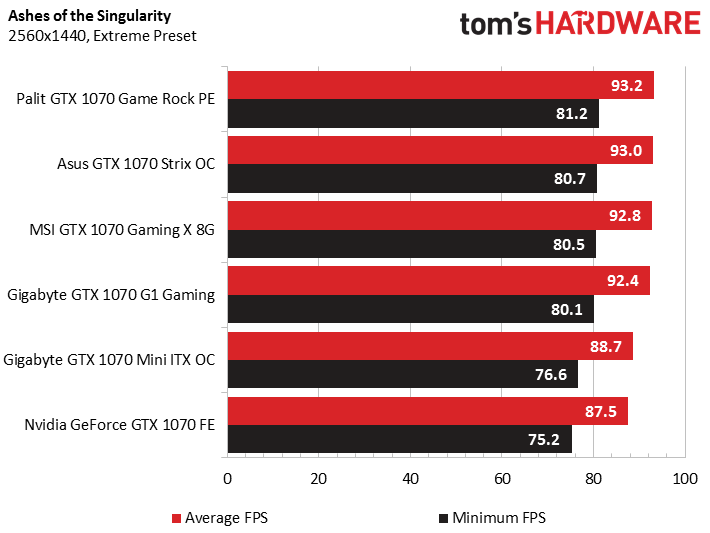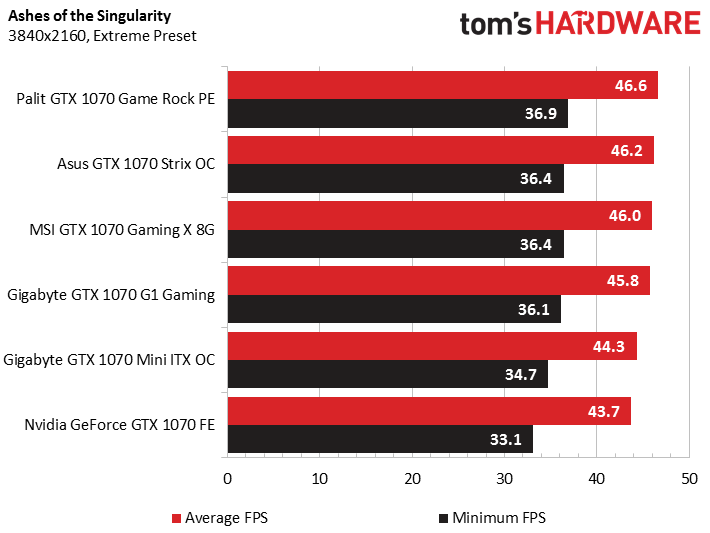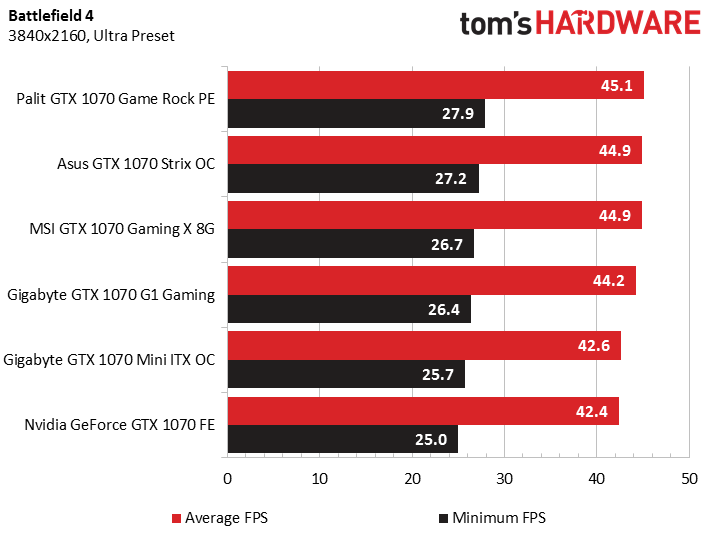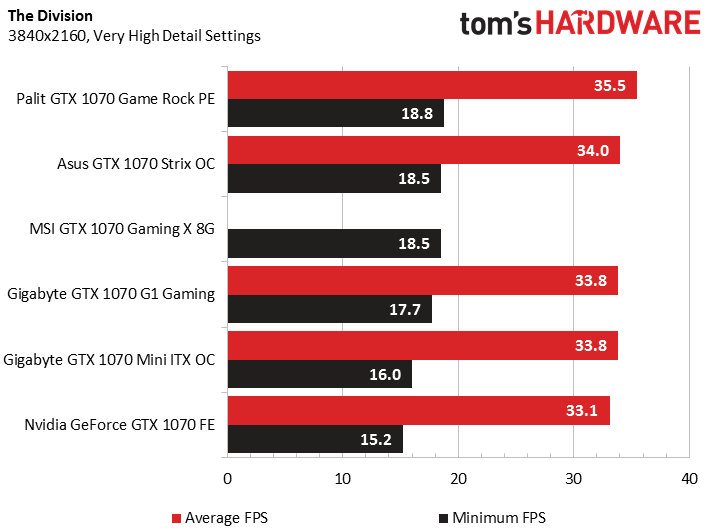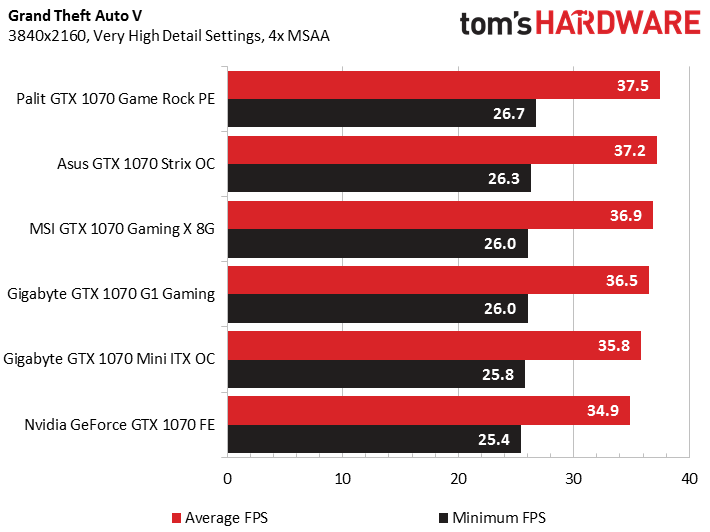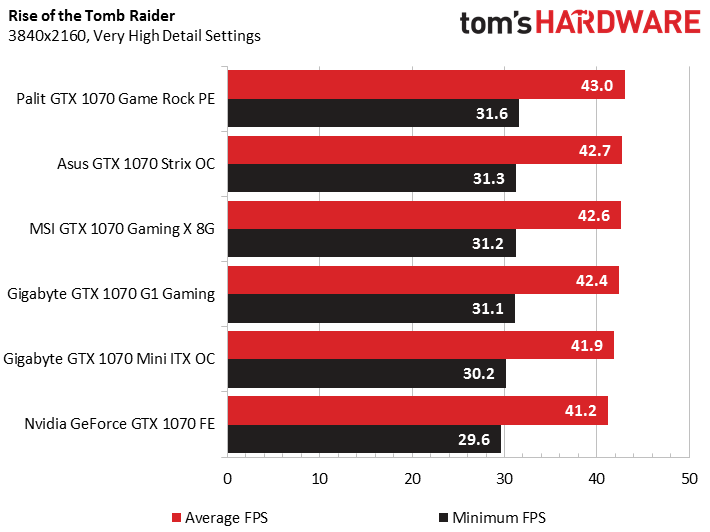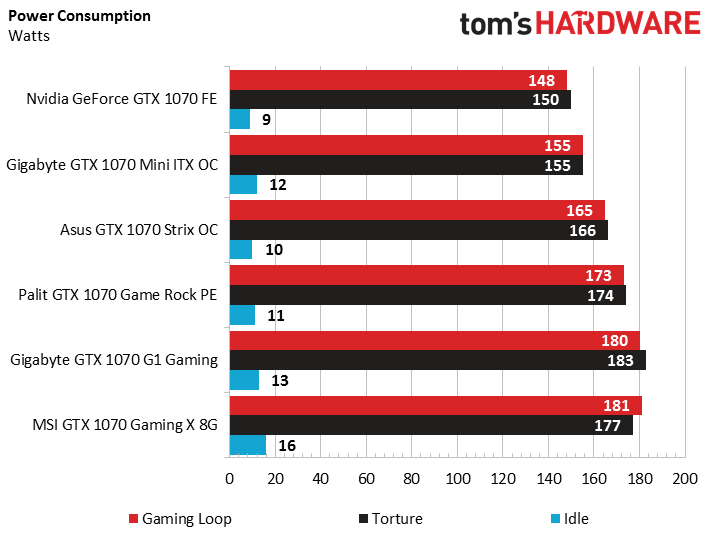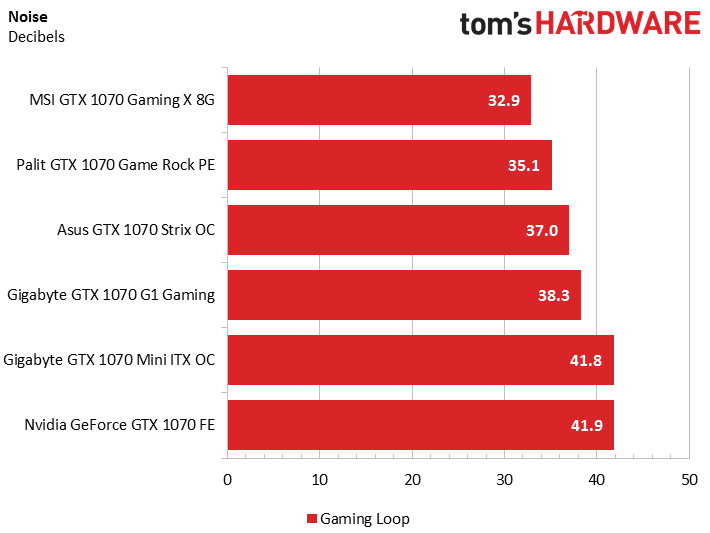Nvidia GeForce GTX 1070 Graphics Card Roundup
Benchmark Results
Why you can trust Tom's Hardware
Gaming
We test every card after a suitable warm-up period to avoid unfair differences in GPU Boost frequencies. All benchmarks are run six times; the first one is used to get the GPU hot again.
These cards are all press samples operating at the same settings as retail models in our best effort to ensure one vendor doesn't get a leg up on another using non-representative clock rates.
The following galleries each contain four images, covering two tested resolutions. We put our focus on QHD (2560x1440) and UHD (3840x2160), plotting out average and minimum frame rates for each resolution in separate graphs.
Ashes of the Singularity
Battlefield 4
The Division
Grand Theft Auto V
Hitman
Project CARS
Rise of the Tomb Raider
The Witcher 3
All of the factory-overclocked cards offer similar performance, more or less. That's why our primary focus centers on evaluating the more technical aspects of each board design, along with their coolers. This is where differences in noise, power, and temperatures are most likely to come from.
Power Consumption
We begin by comparing the power consumption of each card in our gaming loop, stress test, and at idle. Depending on the power targets specified by each manufacturer, we sometimes measured substantial differences. We're ignoring the decimal places in our bar graphs, since those values are too small and would be within measurement tolerances.
We also found that some cards with lower power targets started to throttle during our stress test, resulting in lower power consumption numbers. This did not, however, have a negative impact on general gaming performance for any of the tested cards, as the stress test merely represents a worst-case scenario.
We confirmed that MSI's retail cards will ship with a slightly lower power target (max. 240 to 250 watts) after an internal discussion and evaluation of our measurements.
This also applies to the BIOS versions with OC mode enabled by default, which employ a roughly 20 MHz-higher base and GPU Boost frequency. In the interest of fairness, we tested both MSI cards using normal mode, without the overclocked base and GPU Boost rates. This doesn't affect our power consumption measurements, though.
Noise
For the following comparison, we divide all of the gallery's bar graphs into gaming loop and idle, even if "noise" in practice spans a wide spectrum and the "character" of the sound varies a lot, with each card having highly individual results. Therefore, it is important not to compare just the absolute numbers, but also the frequency spectrum we're presenting.
Many of the cards implement a semi-passive mode, where their fans remain off when the card is idle. Thus, we refrained from taking measurements in that state. Even in our anechoic chamber, levels of 22 dB(A) and below merely represent ambient noise.
Temperatures
For this comparison, we divide the gallery's bar graphs into gaming loop, stress test, and peak temperatures measured on the MOSFETs.
We occasionally compared the temperatures on our benchmark table with those measured inside a closed case and found them to be no more than two or three Kelvin higher.
Since temperatures in a closed case also depend heavily on the enclosure's cooling performance, the only representative and reproducible values are those measured on our benchmark table. Those are the ones we compare.
MORE: Best Graphics Cards
MORE: Desktop GPU Performance Hierarchy Table
MORE: All Graphics Content
Current page: Benchmark Results
Prev Page Introduction & Overview Next Page Nvidia GTX 1070 Founders EditionGet Tom's Hardware's best news and in-depth reviews, straight to your inbox.

Igor Wallossek wrote a wide variety of hardware articles for Tom's Hardware, with a strong focus on technical analysis and in-depth reviews. His contributions have spanned a broad spectrum of PC components, including GPUs, CPUs, workstations, and PC builds. His insightful articles provide readers with detailed knowledge to make informed decisions in the ever-evolving tech landscape
-
adamovera Archived comments are found here: http://www.tomshardware.com/forum/id-3283067/nvidia-geforce-gtx-1070-graphics-card-roundup.htmlReply -
TheRev MasterOne Asus ROG Strix GeForce GTX 1070 and Gigabyte GeForce GTX 1070 G1 Gaming pics are switched ! Did I win something? a job?Reply -
eglass Disagree entirely about the 1070 being good value. It's the worst value in the 10-series lineup. $400 for a 1070 is objectively a bad value when $500 gets you into a 1080.Reply -
adamovera Reply
The filenames of the images are actually swapped as well, weird - fixed now, thanks!19761809 said:Asus ROG Strix GeForce GTX 1070 and Gigabyte GeForce GTX 1070 G1 Gaming pics are switched ! Did I win something? a job? -
barryv88 Are you guys serious!?? You recommend a 1070 card that costs $530 which isn't even available in the U.S? That sorta cash gets you a much quicker GTX 1080! The controversy on this site is just non stop. If your BEST CPU's list wasn't enough already...Reply -
bloodroses I wonder how the Gigabyte 1070 mini compares to the other mini cards like the Zotac and MSI unit?Reply -
adamovera Reply
This is a roundup of all the 1070's we've tested. The graphics card roundups originate with our German bureau and are re-posted in the UK, so they'll sometimes include EU-only products - I'm guessing they're appropriately priced to the competition in their intended markets.19761907 said:Are you guys serious!?? You recommend a 1070 card that costs $530 which isn't even available in the U.S? That sorta cash gets you a much quicker GTX 1080! The controversy on this site is just non stop. If your BEST CPU's list wasn't enough already...
The Palit received the lowest level award - the Asus, the MSI, and one of the Gigabyte boards are better options. -
JackNaylorPE Reply19761822 said:Disagree entirely about the 1070 being good value. It's the worst value in the 10-series lineup. $400 for a 1070 is objectively a bad value when $500 gets you into a 1080.
The 1080 , like it's predcessors (780 and 980) has consistently been the red headed stepchild of the nVidia lineup. So much so that nVidia even intentionally nerfed the performance of the x70 series because its performance was so close to the x80.
The 1080 has dropped in price because, sitting as it does between the 1080 Ti and the 1070... it doesn't exactly stand out. When the 780 Ti came out, the price of the $780 dropped $160 overnight, so much so that I immediately bought two of them and the two sets of game coupons knocked $360 off my XMas shoping list. At a net $650, it was a good buy.
Using the 1070 FE as a reference and the relative performance data published by techpowerup for example.....Used MSI Gaming model since it is one model line where TPU reviewed all 3 cards
The $404 MSI 1070 Gaming X is 104.2% as fast as the 1070 FE
The $550 MSI 1080 Gaming X is 128.2% as fast as the 1070 FE
The $740 MSI 1080 Ti Gaming X is 169.5% as fast as the 1070 FE
So the cost per dollar for comparable quality designs is:
MSI 1070 Gaming X = 104.2 / $404 = 0.258
MSI 1080 Gaming X = 128.2 / $550 = 0.233
MSI 1080 Ti Gaming X = 169.5 / $740 = 0.229
Even at $500 .. the 1080 only comes in 2nd place at 0.256, so no, the better value argument doesn't hold, even assuming we were getting an equal quality card.
Looked at other comparable as a means of comparison and they are for the most par equal or higher ....
Strix at $420, $550 and $780
AMP at $435, $534 and $750
Now with any technology, eeking those last bits of performance out anything always comes at a increased cost. You more of a cost premium going from Gold to Platinum rating on a PSU than you do from Bronze to Silver of even Gold. It's simply another example of Law of Diminishing Returns. So we should expect to pay more per each performance gain with each incremental increase and that hold here. You'd expect that for each increase in performance the % increase in price per dollar would get bigger. But the x80 is quite an aberration.
We get a whopping 10.7 drop of 0.025 from the 1070 to the 1080
We get a rather teeny 1.7 drop of 0.004 from the 1080 to the 1080 Ti
Therefore, logically.... you are paying a 10.7% cost penalty for the increased performance to move up to from the 1070 to 1080 ... whereas the cost penalty for the increased performance to move up to from the 1080 to 1080 Ti is only 1.7% This is why eacxh time the Ti has been introduced, 1080 sales have tanked.
Another way t look at it...
1070 => 1080 = 23% performance increase for $146 ROI = 15.8%
1080 => 1080 Ti = 32% performance increase for $190 ROI = 16.8 %
It's not a matter **if** you can get **a** 1080 at $500., it's whether you can get the one you want. How is it that the $550 models have more sales than the less expensive ones ? Some folks don't care about noise, some folks don't OC, some folks hope they will be able to get the full performance available to us **if** someone ever comes out with a BIOS editor. And yes, there will cards that are heavily discounted for any number of reasons ... low factory clock, noise or heat concerns , some have taken some hits from bad reviews or are discounted simply because sales are poor .... but if a card is selling well below the average price it is because it's not as well made or just isn't selling for real or imagined issues. (example being EVGA SC / FTW ACX designs are now fixed but but EVGA still has a black eye from the earlier cooler problems and if buying EVGA, peeps want iCX. Finally, the 1080 bears the burden of being compared with the 780 and 980 whicc again got lost between the higher / lower cards.
Given the above ROI numbers, I am surprised that all the 1080s have not dropped below $500. But to my eyes, the `080 only starts to make sense when the cost is below $520 and **the ones I'd buy** just aren't there yet
-
Adroid Yea I refuse to buy a 1070 because they are overpriced, period. I almost bought a 1080 but judging from the performance difference it simply wasn't worth it, either. There is not much a 1080 will do that a 1070 won't. What I mean is - a 1060 will run 1080p fine. With that in mind, a 1080 gives very marginal benefit at 2k, and neither one will run 4k smoothly - so what's the point.Reply
If the 1080 was a 350$ card, I might have bit, but as it stands now I'll be waiting for the 1080ti to drop a bit, which can run most games in 2k over 120fps - and justifying an upgrade from a GTX 700 series card. I'm not going to pay over $400 for a card that won't smoke my GTX 770... I can play all games on moderate settings now, so I want ultra settings at 2k that make use of a 144hz monitor - or bust. -
tyr8338 I`m using gigabyte 2 fan 1070 for over a year now and it`s really good, it`s good overclocker and is running at 1974 mhz overclock 24/7 and 8600 on ram, probably it would be able to go even higher but it`s fine for me :) It`s quiet but at around 50% fan speed it produces some strange vibration sound sometimes, it dosn`t bother me all that much tbh but it can be a little annoying.Reply
